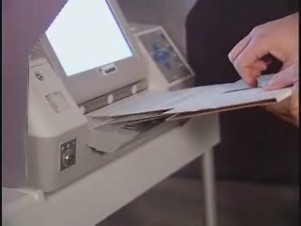New York City and national media have been abuzz all week over a city health department pamphlet that provides harm reduction tips to injection drug users. But despite the offensive led by a right wing tabloid and a handful of professional drug warriors, harm reduction won the battle -- but what about the larger war?
A pair of sociologists get inside a San Diego area network of campus drug sellers and users to ask and answer the question of why privileged youth on the path to success would risk everything to peddle pot or pills. The short answer? They're not really very much at risk -- they're rich and white.
The New Jersey legislature has become the first in the nation to pass a bill reforming mandatory minimum school zone laws. Gov. Jon Corzine has said he will sign it.
The death toll has risen every year since Mexican President Felipe Calderon declared war on the cartels in December 2006. More than 2,000 in 2007, more than 5,000 in 2008, and last year's toll was 7,724. And there are 137 more already this year.
Sheriffs gone wild, narcs gone greedy, a jail guard gone horny, and a couple of jail guards gone dumb.
Will the fourth time be the charm? Organizers of a new "tax and regulate" marijuana initiative in Nevada hope so as they roll out a campaign aimed at the November 2012 election.
A Colorado judge has delivered a shot across the bow to towns and cities moving to ban medical marijuana dispensaries on the grounds they violate federal law.
A California judge can order a medical marijuana patient to hand in his ID card and give up his medicine if he wants to go on probation instead of to prison, an appeals court has ruled in a 2-1 decision. The ruling provoked a harsh dissent.
In a political maneuver to silence critics while Canada hosts the Winter Olympics, Prime Minister Steven Harper has shut down parliament until a new session begins in March. The move kills a harsh bill that was one vote from passage and would have imposed mandatory minimum prison sentences on people growing as a little as a single marijuana plant.
Belgians, Frenchmen, Germans, and other "drug tourists" looking to score on the Dutch border have won a temporary reprieve, as officials in Limburg have delayed plans to make cannabis cafes members only.
Events and quotes of note from this week's drug policy events of years past.
"It's Time to Legalize Medical Marijuana in Professional Sports," "Cocaine Vaccine Backfires Horribly," "Former Drug Czar Invents Awesome New Drug," "Consider the Possibility That People Do Drugs Because They Enjoy It," "States Don't Need Federal Permission to Legalize Medical Marijuana," "Cop Wants His Job Back After Planning the Sting That Killed Rachel Hoffman," "Why is DEA Condemning Efforts to Prevent Heroin Deaths?," "Judge Reprimanded for Illegally Drug Testing Random Guy," "Romantic Comedy 'It's Complicated' Gets R Rating for Depicting Casual Marijuana Use."
Harm reduction in New York City came under attack last weekend when the tabloid New York Post ran an article titled Heroin for Dummies, excoriating the city for spending $32,000 for a 2007 harm reduction pamphlet that, among other things, gave injection drug users advice on how to reduce the harm of injecting. Since then, the story has been picked up by the New York Times and national media, including CNN and Fox News.
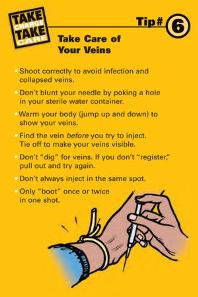
uncomfortable, but the right thing to do
But while the assault on evidence-based harm reduction practices is worrisome, it also sparked a vigorous defense of the pamphlet from Mayor Michael Bloomberg and city health officials and has provided an opportunity to broaden public awareness of harm reduction. By Thursday, despite demands that they be pulled, Health Commissioner Thomas Farley had decided that
the pamphlets will continue to be distributed.
The pamphlet, Take Charge, Take Care, was distributed by the city's Department of Health and Mental Hygiene and was aimed at injection drug users in the city. The harm reduction purpose behind it was to save lives and prevent overdoses and the spread of blood-borne disease. It counsels things like quitting, not sharing needles, and seeking treatment.
But also included in its advice were things like "Find the vein before you try to inject," "If you don't register [hit the vein], pull out and try again," and "Warm your body (jump up and down) to show your veins." Such common-sense harm reduction advice was like waving a red flag for Post and the drug warriors it interviewed.
"It's basically step-by- step instruction on how to inject a poison," said John Gilbride, head of the DEA's New York office. "It concerns me that the city would produce a how-to on using drugs," Gilbride said. "Heroin is extremely potent. You may only get the chance to use it once. To suggest there is a method of using that alleviates the dangers, that's very disturbing."
"It's sick," said City Council member Peter Vallone Jr. (D-Queens), chair of the council's public safety committee, who vowed to try to shut down distribution of the pamphlet. "This is a tremendous misuse of city funds, and I'm going to see what I can do to stop it. It sends a message to our youth: give it a try," he fumed.
"What we do not want to do is suggest that there's anything safe about shooting up narcotics," said Bridget Brennan, the city's special narcotics prosecutor. "No matter how many times you wash your hands or how clean the needle is, it's still poison that you're putting in your veins."
Only at the very end of the Post article was any supporter of harm reduction or the pamphlet given a say. "Our goal is to promote health and save lives with this information," explained Daliah Heller, assistant commissioner for the Bureau of Alcohol and Drug Use Prevention, Care and Treatment. "From a health perspective, there is a less harmful way to inject yourself."
The New York Times article the following day was less one-sided than the Post's hit piece, but still gave Vallone and other critics top billing. "You're spending taxpayer money and getting a how-to guide for first-time users," Vallone claimed.
The pamphlet was "absolutely not" a how-to manual, Dr. Adam Karpati, executive deputy commissioner for the health department's division of mental hygiene, told the Times. "Our primary message, as it is in all our initiatives, is to help people stop using drugs and to provide them with information on how to quit," Karpati said, adding that health officials recognized that quitting was not a realistic expectation for all drug users.
While Karpati was playing defense, harm reduction supporters went on the offensive. "The Health Department's booklet is solidly grounded in science and public health," said Ethan Nadelmann, executive director of the Drug Policy Alliance. "But the same cannot be said of the irresponsible comments by John Gilbride, Bridget Brennan, and Peter Vallone, Jr. These sorts of reckless statements by top level city and federal law enforcement agents need to be repudiated by their superiors in city and federal government."
On Monday, Mayor Bloomberg defended the pamphlet. "I would certainly not recommend to anyone that they use hard drugs or soft drugs," Bloomberg said. "But our health department does have an interest in if you're going to do certain things to get you to do it as healthily as you possibly can."
Now that the flap is behind them, two leading harm reductionists are assessing what it all means. "There was a political agenda at work with this," said Allan Clear, head of the Harm Reduction Coalition. "The District Attorney's Office fed this to the Post. This is a deliberate attack, and it follows on the footsteps of Rockefeller drug law reform, where DAs had some of their power stripped away. This was a red rag for foes to wave to provoke people, when the amount spent on the brochure is relatively small."
"This was not a book for people who have never injected," said Robert Heimer, professor at the Yale School of Public Health. "We know that people use opiates for around three years before they start injecting, and they don't do it because of a pamphlet, but because they are following their friends' example. This pamphlet was distributed at needle exchanges, STD clinics, drug treatment centers, and to people leaving Rikers Island. That's who the audience is, not people who have never injected."
Neither Clear nor Heimer thought much of the press coverage, although Clear was more charitable to the Times than Heimer. "The brochure has been deceptively portrayed consistently in all the articles," said Clear. "This is a manual aimed at people who are using injection drugs. The first thing it says is if you want help, call this number. If you compare the articles in the Post and the Times, the anti-drug user invective in the Post was just horrendous and demonstrated a very biased position to begin with," said Clear. "The conversation in the Times was much more pro-public health and sympathetic."
"The Times article was incredibly negative," said Heimer. "The first eight or ten paragraphs were all the opposition, and only after that do you get to the health department and why it's a common sense public health approach. When you have 'liberal media' like the Times and rightwing Murdoch papers like the Post both condemning you, you are under a lot of pressure to change."
When all is said and done, did the pamphlet flap turn out to be a boon or a bane for harm reduction? Again, the two men differed.
"When you get this on Fox News or CNN and people are talking about it, even though the initial effort was to discredit the brochure, it actually brought harm reduction to public consciousness in a good way," said Clear. "While we feel attacked, there has been a lot of positive response, and this has raised the profile of harm reduction and the need to educate drug users. The public reaction hasn't been that bad; in fact, it's been quite good."
"Any time there is negative press, it's not good for harm reduction," said Heimer. "It's still fragile here. In places like Holland, Britain, Canada, and Australia, harm reduction is one of the four pillars -- prevention, treatment, law enforcement, harm reduction -- but in this country, very little is done about prevention, there is not enough drug treatment because there is not enough emphasis on demand reduction, and we spend all our money on supply reduction, and we know how that has worked."
back to top
Phillip S. Smith, Writer/Editor
Whom do you picture when you read the phrase "drug dealer"? It's probably not the subjects of this book. They're white, upper-middle class and beyond, upwardly mobile college students blithely enmeshed in a web of criminality -- drug use and sales -- that, for them at least, goes unnoticed, and even when noticed, largely unpunished.
And that really irks Mohamed and Fritsvold, a pair of Southern California sociologists who gained entrée into a network of drug sellers and users centered on a private college in San Diego and then spent six years interviewing and observing them as they partied hearty, gobbled and swapped pills, and peddled dope with reckless abandon. It's not, as the authors make clear, that they wish their student subjects were punished with the same heavy hand awaiting a poor black kid slinging crack in on an inner city street corner.
In fact, Mohamed and Fritsvold make equally clear that they view US drug policies as harsh and counterproductive, in no small part because of the race and class biases they so inarguably exhibit. Healthy chunks of "Dorm Room Dealers" are devoted to delineating in detail just how racially skewed and cleaved by class the application of American drug laws are. That's what really irks the authors.
And that partially answers the questions the authors posed at the beginning of the book. Why do privileged college students -- who have everything to lose and little to gain -- choose to sell drugs? Well, because they can do so with almost total impunity. They are not the target of the drug war. They're the wrong color and the wrong class. They essentially get a free pass -- from police, who ignore them; from college administrators, who don't want to upset their parents; from doctors, who are happy to prescribe them whatever pills they desire... because they are the children of "good people," i.e. white and wealthy people.
Mohamed and Fritsvold show repeatedly the reckless abandon with which their subjects went about their business: Dope deals over the phone with uncoded messages, driving around high with pounds of pot in the car, doing drug transactions visible from the street, selling to strangers, smuggling hundreds of pills across the Mexican border. These campus dealers lacked even the basics of drug dealer security measures, yet they flew under the radar of the drug warriors.
Even when the rare encounter with police occurred, these well-connected students skated. In one instance, a dealer got too wasted and attacked someone's car. He persuaded a police officer to take him home in handcuffs to get cash to pay for the damages. The cop ignored the scales, the pot, the evidence of drug dealing, and happily took a hundred dollar bill for his efforts. In another instance, a beach front dealer was the victim of an armed robbery. He had no qualms about calling the police, who once again couldn't see the evidence of dealing staring them in the face and who managed to catch the robbers. The dealer wisely didn't claim the pounds of pot police recovered and didn't face any consequences.
Even when the rare arrest for drug dealing occurred, these folks emerged relatively unscathed. With daddy's money and daddy's lawyers, serious felony charges evaporate. One dealer who could have gone to prison for years ended up with probation for a misdemeanor, which was subsequently wiped from his record. Ah, privilege -- ain't it sweet?
The lack of consequences for breaking drug laws may help explain the students' almost universal lack of interest in drug law reform. These student dope-slingers were not SSDP types. Only one of the two dozen or so dealers watched by Mohamed and Fritsvold expressed any interest in changing the laws. Why should these folks care about reforming the drug laws? They appear to be irrelevant to their lives. Perhaps if these privileged students were subjected to the wrath of the drug war the same way their poorer, darker-skinned counterparts were, they and their powerful parents might begin to feel compelled to address the drug laws. Until then, not so much.
These student dealers were mostly vending pot, with a few offering cocaine and ecstasy as sidelines. There was no mention of heroin or methamphetamines. One finding that surprised the authors was the prevalence of the pill culture. Students were gobbling down Valium, Xanax, Oxycontin, Lorcet, Vicodin, Adderall and Ritalin like crazy, swapping or selling excess pills, lying to doctors to get prescriptions, even smuggling in loads obtained in Tijuana strip joints.
The pill-poppers felt even less like criminals than the illicit drug dealers did. All of the students were able to rationalize their lawbreaking, in part, the authors suggest, because they never really self-identified as dope dealers. After all, dope dealers live in the inner city, are poor, and are a different color. For the subjects of "Dorm Room Dealers," collegiate dope-dealing was incidental, a passing phase on their road to mainstream success as realtors, upper management types, and business owners. They were invested in conventional lives and careers, and, as follow up interviews suggest, as a group they are now doing quite well.
"Dorm Room Dealers" is a valuable contribution to the ethnography of drug use and drug selling and is an interesting read, too. But at $50 for the hardback, you'll probably want to check it out of your campus library or wait for the paperback.
back to top
With a 46-30 vote Thursday, the New Jersey Assembly gave final approval to a bill that will end mandatory minimum sentences for some "drug free zone" drug offenses. The bill passed the Senate in December. Outgoing Gov. Jon Corzine (D) has said he will sign the bill into law. When that happens, New Jersey will become the first state to roll back a mandatory minimum school zone law.

misleading concept
Under a sentencing law in place since 1987, drug offenses that occurred within 1,000 feet of a school incurred mandatory minimum sentences of one to three years. Critics had argued for years that the law had a disproportionate impact on minority inner city residents and that it unnecessarily filled the state's prisons with low-level drug offenders who could be better served by drug treatment. The state spent $331 million last year to imprison drug offenders.
The bill just passed, A2762, would allow judges the discretion to impose a lesser sentence or probation, depending on whether school was in session, how close to a school it was, and whether children were present. Mandatory minimums would stay in effect if the offense took place on school grounds or involved violence or a gun.
According to the state Department of Corrections, 69% of drug offenders doing time are doing mandatory minimums. This bill will allow those doing mandatory minimums for school zone offenses to appeal those sentences.
"The mandatory minimum sentencing the zones require has effectively created two different sentences for the same crime, depending on where an individual lives," said Assembly Majority Leader Bonnie Watson Coleman (D-Mercer), one of the bill's cosponsors. "This is geographic discrimination at its most basic."
"This is a progressive solution to a complex problem," said Assemblyman Gordon Johnson (D-Bergen), another cosponsor.
The legislature's action won praise from sentencing and drug policy reform groups that were part of a broad coalition to pass the bill. "Families Against Mandatory Minimums (FAMM) commends the legislative leaders who fought for smart on crime sentencing policies in New Jersey. State lawmakers are increasingly disenchanted with ineffective and costly mandatory minimum sentences for nonviolent, drug-related offenses and are turning to policies that allow the courts to individualize punishments based on the facts of each case. This move signals a better course for New Jersey, and fairer sentences for low-level, nonviolent drug offenders," said Deborah Fleischaker, FAMM's director of state legislative affairs.
Roseanne Scotti, director of the Drug Policy Alliance New Jersey office, said the vote signals a new willingness on the part of elected officials at both the state and national level to reform failed sentencing and drug policies.
"At one time, these types of mandatory minimum laws were considered untouchable," said Scotti. "But there is a growing public backlash against these failed policies and a growing willingness on the part of elected officials to address the mistakes of the past."
back to top
by Bernd Debusmann, Jr.
Mexican drug trafficking organizations make billions each year trafficking illegal drugs into the United States, profiting enormously from the prohibitionist drug policies of the US government. Since Mexican president Felipe Calderon took office in December 2006 and called the armed forces into the fight against the so-called cartels, prohibition-related violence has killed over 16,000 people, with a death toll of over 7,000 so far in 2009. The increasing militarization of the drug war and the arrest of several high-profile drug traffickers have failed to stem the flow of drugs -- or the violence -- whatsoever. The Merida initiative, which provides $1.4 billion over three years for the US to assist the Mexican government with training, equipment and intelligence, has so far failed to make a difference. Here are a few of the latest developments in Mexico's drug war:
Saturday, January 2
Near Mexico City, two bodies were found killed execution-style in San Pablo de las Salinas. One of the dead was wrapped in a blanket and had signs of torture. The other body was that of a woman in a plastic bag who had apparently been strangled to death. In 2009, the greater Mexico City area was the scene of some 300 drug-related homicides.
In the first 36 hours of 2010, eight people were killed in various incidents across Ciudad Juarez. Four of these deaths occurred just minutes after midnight on New Year's Eve when gunmen killed a family in the south of the city, including a four-year old girl. In another incident, a business owner was killed after being attacked by men wielding automatic weapons.
In other parts of Mexico, the bodies of two young men were found in a rural part of Guerrero, one in Ciudad Renacimiento, two in Sinaloa, including one with a message attached threatening thieves. In Durango, 11 people were killed, including one who was shot dead in the hospital after being wounded earlier in the day. In Tijuana, the year began with the killing of six people across the city. Two dismembered bodies were found in Michoacan, and one man was executed in Torreon, Coahuila.
Sunday, January 3
In Oaxaca, the brother of an indigenous radio broadcaster who was assassinated in 2008 was shot dead in the municipality of San Juan Copala. 15 other people were killed in violence in five Mexican states. Seven of the dead were found in Sinaloa. In Coahuila, the bodies of two federal agents who had been kidnapped and killed in Durango were found in the bed of a pickup truck.
In Ciudad Juarez, two brothers in a drug rehab facility were forcibly removed by gunmen and shot outside. One of them was killed instantly and the other seriously wounded. In another part of the city, two federal agents were involved in a firefight outside a hotel in which they were staying. One of them was killed and another wounded.
Additionally, one man was killed after being ambushed by gunmen in Tijuana and two people were found dead near Mexico City.
Monday, January 4
In the state of Sinaloa, four people were shot dead in several incidents. Among the dead was a man found with a note pinned to his back on the side of a highway.
In Tijuana, the decapitated body of a woman was found at the entrance to a cemetery. In another incident in the city, a police agent in charge of auto theft investigations was killed after being ambushed by gunmen in Mesa de Otay. A civilian traveling with him in the passenger seat was also killed. Although the motive is unclear, auto theft is often related to drug trafficking as stolen cars are used to move narcotics across the US border. Four other people were shot dead with automatic weapons in several other incidents in Tijuana.
In Parras, Chihuahua, the son of the mayor was shot dead. Four people were killed in Ciudad Juarez. Five people were killed in Sinaloa. In one incident, a man in Culiacan reportedly was shot 120 times. In Veracruz, two women were killed when a group of armed men stormed a bus. Two people were killed in Durango, and two decapitated bodies were found in Michoacan.
Soldiers arrested Carlos Beltran Leyva, the brother of cartel boss Arturo, who was killed by naval special forces in December. Carlos was arrested after being caught driving with a fake ID. Weapons and cocaine were found in the car as well.
Tuesday, January 5
In a 24-hour period, 29 people were killed in Chihuahua, including two state police officers. The two policemen were killed by a group of six gunmen as they left a body shop. In addition to the two police officers, 13 other people were killed in the city. Among the dead was a female activist who had brought attention to human rights abuses by the army and the police in Ciudad Juarez. 14 other people were killed in other parts of the state.
Total Body Count for 2009: 7,724
Total Body Count so far for 2010: 137
Read the last Mexico Drug War Update here.
back to top
Sheriffs gone wild, narcs gone greedy, a jail guard gone horny, and a couple of jail guards gone dumb. Let's get to it:

seized cash
In Murphysville, Illinois,
a county sheriff already jailed on marijuana sales charged was arrested again, this time on solicitation of murder charges. Gallatin County Sheriff Raymond Martin, his wife, and his 20-year-old son were all arrested and are being held on one million dollar bonds. Officials have not said if the murder for hire plot is related to the marijuana charges. The trio will have preliminary hearings on the murder conspiracy charges on January 26.
In Mineola, New York, a Long Island corrections officer was arrested December 30 for extorting sexual favors from female inmates. Mark Barber is accused of using his position as grievance officer for the Nassau County Correctional Center to engage in various sexual activities for females. Authorities said Barber targeted inmates with histories of drug abuse, prostitution, or mental health issues. He faces various counts of rape, sexual abuse, and forcible touching and could get up to 16 years in prison if convicted.
In Eufala, Alabama, the Eufala Police narcotics division commander was arrested December 29 for allegedly stealing money that had been seized and was awaiting an asset forfeiture hearing. Lt. Stephen Hanners went down after $20,000 went missing and investigators soon zeroed in on him. He is charged with first degree theft of property. Hanners resigned upon his arrest.
In Lexington, South Carolina, a Lexington County jail guard was arrested December 31 for bringing marijuana and cigarettes to a prisoner. Guard Phillip Fields was accused of conspiring with a woman who was also arrested. The woman left the contraband in Fields' car while he was at work, then he would retrieve the goodies during his shift and smuggle them into the jail. He got busted bringing the contraband in. Fields is charged with two counts furnishing contraband to a prisoner and furnishing drugs to a prisoner, two counts of misconduct in office, and one count of marijuana possession.
In New York City, a Rikers Island jail guard was arrested last Friday as she tried to smuggle drugs, alcohol, and tobacco into the prison. Guard Teneya Griffith, 25, went down after fellow corrections officers went to authorities about their suspicions she was compromised. She got caught with two ounces of weed, three water bottles filled with vodka, and tobacco and cigarettes. According to prosecutors, Griffith was to earn $800 to $900 for her efforts. She is charged with first degree felony promoting prison contraband, misdemeanor promoting prison contraband, marijuana possession, and official misconduct. She faces up to seven years for the felony.
back to top
Organizers of an initiative that would tax and regulate marijuana in Nevada filed it with the secretary of state's office in Carson City Wednesday. That is the first formal step in getting it before voters in the November 2012 elections.
The initiative would:
- Legalize the possession of up to an ounce by adults;
- Provide for up to 120 licensed retail outlets statewide; and
- Provide for up to 50 licensed growers to supply licensed retailers.
Retailers would have to pay a $2,500 licensing fee, and would collect sales tax on retail sales. Growers would have to pay a $5,000 licensing fee and would collect a wholesale tax of $50 an ounce from retailers.
The initiative has no provision for growing your own.
Backers will need to gather 97,002 valid signatures to send the measure to the 2011 Legislature. If lawmakers fail to act, it would be placed on the 2012 ballot.
The initiative is sponsored by Nevadans for Sensible Marijuana Laws, which is backed by the Washington, DC-based Marijuana Policy Project (MPP). MPP and local affiliates have tried three other times in the past decade to legalize marijuana in Nevada. In 2002, voters rejected a proposal to legalize up to three ounces; in 2004, a second attempt failed to make the ballot; and in 2006, a proposal to legalize up to one ounce lost with 44% of the vote.
Backers are counting on changing public attitudes toward marijuana to take them over the top this time. "The environment we feel has changed," said campaign manager David Schwartz at a press conference before filing the papers. "The discussion has become nationwide."
The campaign will hammer away at the increasingly popular "marijuana is safer than alcohol" argument, Schwartz said. "We will encourage voters to consider this fact and decide for themselves whether it makes sense to allow adults to use alcohol freely, but punish them if they choose to use a less harmful substance, marijuana."
That makes five states where marijuana legalization is on the agenda. California is a two-fer, with both a pending legalization bill (which will get a hearing and a committee vote next week) and at least one legalization initiative with a number of signatures gathered that virtually guarantee its qualifying for the ballot. Meanwhile, Massachusetts, New Hampshire and Washington state have legalization bills pending or about to be filed too.
back to top
Colorado medical marijuana patients have a constitutional right to buy it, not just use it, a district judge ruled December 29. The ruling came in a lawsuit by the CannaMart dispensary, which sued the city of Centennial after it banned dispensaries, forcing the dispensary to move to a neighboring community.
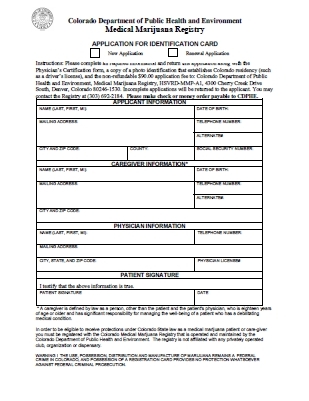
Colorado state medical marijuana application
In banning dispensaries, Centennial had argued that it could ban them because they violated federal drug laws. Using the same argument, other towns in Colorado have banned or are considering banning dispensaries, which have mushroomed in the past year in the wake of state health department administrative rulings and the Obama administration's vow to not harass medical marijuana providers acting within state laws.
But in granting CannaMart's request for an injunction blocking the city from keeping the dispensary closed while it challenges the city's federal argument, Arapahoe County District Court Judge Christopher Cross had some harsh words for cities making that argument. Centennial violated the rights of three medical marijuana patients who joined the lawsuit, he said. "These are people who have a right to medical marijuana, the right to the caregiver of their choice. That has been taken away from them," Cross said.
CannaMart attorney Lauren Davis echoed Judge Cross's words, telling the Associated Press the ruling "should be a warning to towns across this state" that are considering whether to ban dispensaries. "They are violating the rights of sick patients and caregivers," Davis said.
The CannaMart lawsuit against the city of Centennial will continue later this year. But Judge Cross warned that cities trying to ban dispensaries could find themselves in violation of the state constitution. "The voters have spoken. It is not a criminal act in the state of Colorado."
back to top
A California appeals court has ruled that a judge who forbade a defendant from using medical marijuana as a condition of probation acted within his powers. The 2-1 decision was harshly criticized by the dissenting justice, who said it undermines California's voter-approved medical marijuana law.
The ruling by the First District Court of Appeal in San Francisco came in People v. Moret, in which Fairfield resident Daryl Moret, then 19, was arrested in 2008 for carrying a loaded handgun he said he had found in the bushes. Moret pleaded no contest to illegal gun possession, and in an interview with a court probation officer indicated he had obtained a medical marijuana card to treat migraine headaches he had suffered since childhood.
At Moret's December 2008 sentencing hearing, Superior Court Judge Peter Foor said he didn't believe Moret's statements about how he obtained the gun or about medical marijuana. "Smoking dope isn't going to help any of this," the judge said, ordering Moret to surrender his medical marijuana ID card and abstain from marijuana if he wanted to be granted probation. Moret agreed to those terms, but appealed, saying the probation condition violated the medical marijuana law.
In rejecting Moret's appeal, the majority held since a defendant can choose to reject probation conditions and accept a prison sentence, California medical marijuana laws did not limit a judge's ability to forbid drug use as a condition of probation. Justice Paul Haerle wrot that Moret accepted probation voluntarily and offered no evidence to support his need for medical marijuana.
But in a lengthy and harsh dissent, Justice J. Anthony Kline said that a judge's demand that Moret forego medical marijuana or face prison for a non-drug-related offense violated the law's ban on criminal punishments for medical marijuana users. A judge "may disagree with the aims and directives of [the medical marijuana law], but... cannot defy them," Kline said.
A medical marijuana ID card is all the proof a patient needs under state law, said Kline. The sentencing judge could have held a hearing if he questioned the medical marijuana card's legitimacy. Merely because the defendant agreed under coercion to the restriction does not make the restriction legal, Kline added.
Moret and his attorney are considering whether to appeal to the state Supreme Court.
back to top
In a political maneuver designed to shield his embattled Conservative government from criticism during the upcoming Winter Olympics in Vancouver, Canadian Prime Minister Steven Harper on December 30th "prorogued," or shut down, Parliament until a new session begins in March. The move kills all pending legislation, including a Tory "tough on crime" bill, C-15, that included mandatory minimum nine-month prison sentences for growing as much as a single marijuana plant.
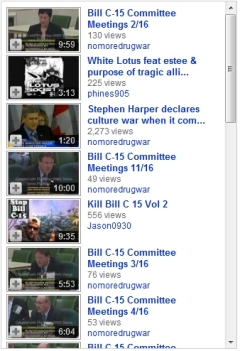
Proroguing parliament is not a routine move, but this is the second time Harper has done it in a year. Last December, he did it to head off a looming vote of no-confidence, with a coalition of New Democrats, Liberals, and Bloc Quebecois looking to replace his Conservative government. Now, he says he is doing it to introduce a new budget, but the maneuver also kills all parliamentary committees, including one looking into allegations Canadian soldiers in Afghanistan turned detainees over to Afghan authorities who abused them. That inquiry has raised embarrassing questions about Canada's policies in Afghanistan.
To the relief of drug reform advocates and Canada's cannabis culture, the move kills a bill that was very harsh and very near to passage. Under the provisions of C-15 as passed by the House, people growing between one and 200 marijuana plants faced a minimum of six months if the "offense is committed for the purpose of trafficking." That would rise to nine months if it were a rental property, if children were endangered, or if the grow presented a public safety threat, i.e. was stealing electricity.
The bill mandated a one-year minimum for between 201 and 500 plants or for producing hashish and two years for more than 500 plants. It also had one-year minimums for importing or exporting marijuana and for trafficking more than three kilograms if it was for the benefit of "organized crime," there was threat or use of violence or weapons, or if the offender had a serious previous drug offense. The trafficking minimum jumped to two years if it occurred in a prison, if the trafficking was to a minor, or if it was "in or near a school, in or near an area normally frequented by youth or in the presence of youth."
The bill had been amended earlier this month by the Senate Constitutional Affairs and Legal Committee to remove the mandatory minimum provisions for under 201 plants, but only if the grows were not in residential areas and owned by the grower. That meant anyone growing in a residential neighborhood or in a rental property still faced a nine-month minimum, limiting relief to rural home-owners.
The bill awaited only a final vote in the Senate. Now, Harper has sacrificed it on the altar of his political calculations. But like a vampire, C-15 is likely to rise from the grave. It has been a central plank in Harper's appeals to his law-and-order constituencies, and his government is almost certain to reintroduce it when the new session begins in March, or after he calls snap elections, which the Conservatives seem well-positioned to win as their main rivals, the Liberals, flounder.
Don't put away those wooden stakes just yet.
back to top
A plan to make Dutch border town cannabis cafes members only in a bid to thwart "drug tourism" is on indefinite hold, a Dutch official said Monday. The plan, which was supposed to go into effect January 1, needs further study, the official said.

downstairs of a coffee shop, Maastricht (courtesy Wikimedia)
"We need to finalize our preparations before we can put the project into operation," said Petro Hermans, a project officer for the southeastern city of Maastricht. "We are studying the legal feasibility of the project," he said, adding the date of January 1 "was not practicable."
Maastricht is one of eight municipalities in southern Limburg province that announced jointly last May they would make the 30 coffee shops in their jurisdictions members only. The plan would also reduce the daily limit on marijuana purchases from five grams to three and require that payment be made with a Dutch debit card.
The measures are a bid to reduce the estimated four million visitors to Limburg each year who come from more repressive neighboring countries -- France, Germany, and Belgium -- to buy marijuana. Limburgers have complained that the drug tourists cause problems ranging from traffic congestion to public urination to hard drug dealing.
The Dutch government decriminalized the possession of up to five grams of marijuana in 1976 and allows for retail sales through licensed coffee shops. There are about 700 coffee shops throughout the country.
Back in Limburg, Hermans said that a report on the feasibility of the members-only plan was due by mid-month. "We will then decide how to proceed," he said.
back to top
January 11, 1906: LSD inventor Dr. Albert Hofmann is born.
January 9, 1923: US Labor Secretary Davis endorses the idea of a national campaign against the peril of habit-forming drugs.
January 11, 1923: The New York Times publishes the article "Marihuana Is Newest Drug," and claims the State of New York has 50,000 drug addicts.
January 12, 1929: The Porter Narcotic Farm Act is passed, establishing the first two narcotics hospitals for addicts in federal prisons in response to addicts' crowding.
January 14, 1937: A private federal cannabis conference takes place in room 81 of the Treasury Building in Washington, DC, leading to enactment of federal marijuana prohibition later that year.
January 8, 1990: General Manuel Noriega is convicted on eight counts of drug trafficking, money laundering, and racketeering, and sentenced to 40 years in Federal prison.
January 9, 1996: DEA agents in Miami arrest Jorge Luis Cabrera, a 1995 $20,000 donor to the Democratic Party who was invited to a Christmas party that year by Hillary Rodham Clinton. He is busted along with four partners in possession of 6,000 pounds of cocaine.
January 8, 1998: Rep. Bobby Moak's (R-Lincoln County) Mississippi House Bill 196 proposes "The removal of a body part in lieu of other sentences imposed by the court for violations of the Controlled Substances Law." Moak tells reporters that he introduced the legislation because he felt the state wasn't doing enough to combat drug use. Provisions in the bill mandate that the convicted person and the court "must agree on which body part shall be removed."
January 12, 2001: Salon.com reports that the nephew of Attorney General-designate John Ashcroft received probation after a felony conviction in state court for growing 60 marijuana plants with intent to distribute the drug in 1992. This is a lenient sentence, given that these charges often trigger much tougher federal penalties and jail time. Ashcroft was the tough-on-drugs Missouri governor at the time.
January 14, 2003: A high profile pain prosecution ends with a whimper when California prosecutors dismiss all remaining charges against Dr. Frank Fisher.
back to top
Along with our weekly in-depth Chronicle reporting, DRCNet also provides daily content in the way of blogging in the Stop the Drug War Speakeasy -- huge numbers of people have been reading it recently -- as well as Latest News links (upper right-hand corner of most web pages), event listings (lower right-hand corner) and other info. Check out DRCNet every day to stay on top of the drug reform game! Check out the Speakeasy main page at http://stopthedrugwar.org/speakeasy.
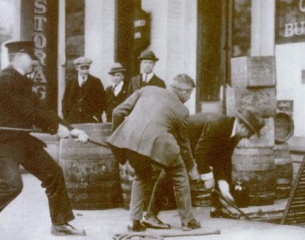
prohibition-era beer raid, Washington, DC (Library of Congress)
Since last issue:
Scott Morgan writes: "It's Time to Legalize Medical Marijuana in Professional Sports," "Cocaine Vaccine Backfires Horribly," "Former Drug Czar Invents Awesome New Drug," "Consider the Possibility That People Do Drugs Because They Enjoy It," "States Don't Need Federal Permission to Legalize Medical Marijuana," "Cop Wants His Job Back After Planning the Sting That Killed Rachel Hoffman," "Why is DEA Condemning Efforts to Prevent Heroin Deaths?," "Judge Reprimanded for Illegally Drug Testing Random Guy," "Romantic Comedy 'It's Complicated' Gets R Rating for Depicting Casual Marijuana Use."
Phil Smith posts early copies of Drug War Chronicle articles.
David Guard posts numerous press releases, action alerts and other organizational announcements in the In the Trenches blog.
Again, http://stopthedrugwar.org/speakeasy is the online place to stay in the loop for the fight to stop the war on drugs. Thanks for reading, and please join us on the comment boards.
back to top




